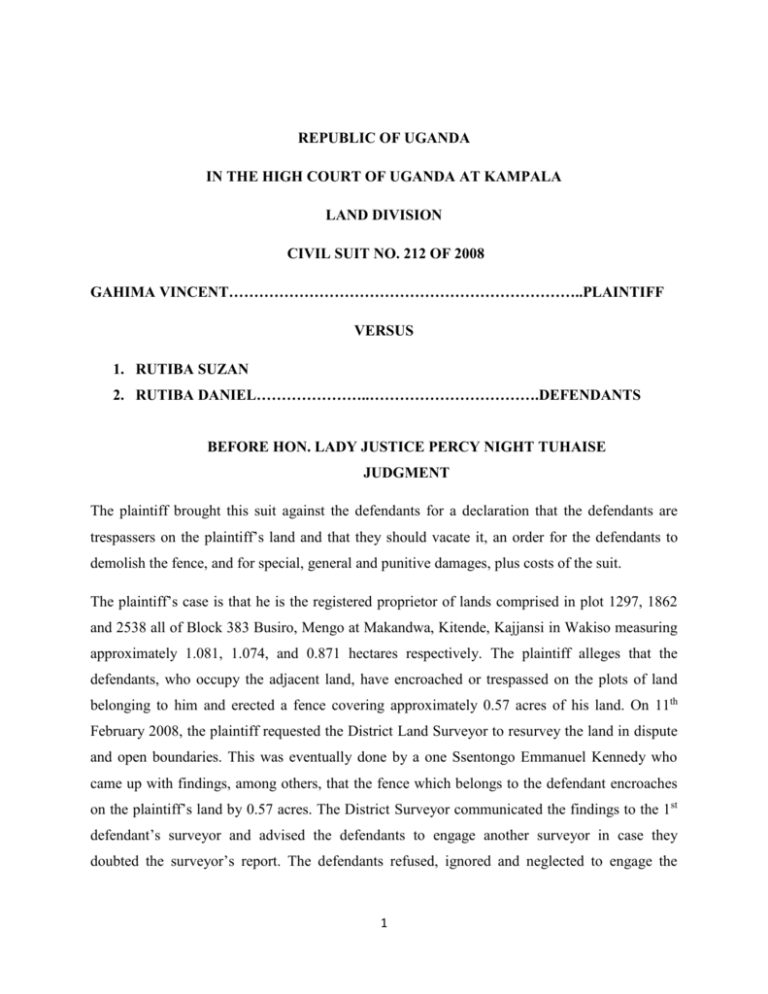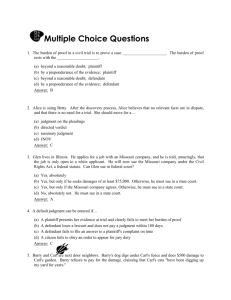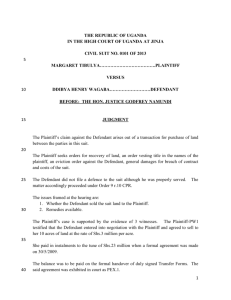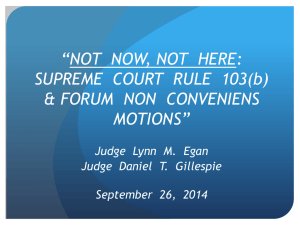GAHIMA VINCENT V RUTIBA SUZAN RUTIBA DANIEL C
advertisement

REPUBLIC OF UGANDA IN THE HIGH COURT OF UGANDA AT KAMPALA LAND DIVISION CIVIL SUIT NO. 212 OF 2008 GAHIMA VINCENT……………………………………………………………..PLAINTIFF VERSUS 1. RUTIBA SUZAN 2. RUTIBA DANIEL…………………..…………………………….DEFENDANTS BEFORE HON. LADY JUSTICE PERCY NIGHT TUHAISE JUDGMENT The plaintiff brought this suit against the defendants for a declaration that the defendants are trespassers on the plaintiff’s land and that they should vacate it, an order for the defendants to demolish the fence, and for special, general and punitive damages, plus costs of the suit. The plaintiff’s case is that he is the registered proprietor of lands comprised in plot 1297, 1862 and 2538 all of Block 383 Busiro, Mengo at Makandwa, Kitende, Kajjansi in Wakiso measuring approximately 1.081, 1.074, and 0.871 hectares respectively. The plaintiff alleges that the defendants, who occupy the adjacent land, have encroached or trespassed on the plots of land belonging to him and erected a fence covering approximately 0.57 acres of his land. On 11th February 2008, the plaintiff requested the District Land Surveyor to resurvey the land in dispute and open boundaries. This was eventually done by a one Ssentongo Emmanuel Kennedy who came up with findings, among others, that the fence which belongs to the defendant encroaches on the plaintiff’s land by 0.57 acres. The District Surveyor communicated the findings to the 1st defendant’s surveyor and advised the defendants to engage another surveyor in case they doubted the surveyor’s report. The defendants refused, ignored and neglected to engage the 1 services of another surveyor despite the directive. The plaintiff avers that he has been subjected to damage and loss as a result of the defendants’ conduct for which he seeks special damages. The defendants’ case is that they are co administrators of the estate of Professor Reverend Canon Dr. Rutiba who at all material times make decisions affecting the estate. The 1 st defendant in her capacity as widow and co administrator resides at her matrimonial home on land adjacent to the plaintiffs. The 1st defendant invited the plaintiff to be her neighbor in good faith after purchasing, together with her late husband, several bibanja from at least three bibanja holders. Afterwards they planted a traditional/natural hedge or fence around the land, including one separating the estate’s land from the land currently occupied by the plaintiff. The defendants assisted the plaintiff to trace the registered proprietor of the suit land and the 2nd defendant acted as the plaintiff’s attorney. The defendants deny encroaching on the plaintiff’s land and claim that the land currently occupied by the 1st defendant was purchased and occupied long before the plaintiff bought the suit land. The parties filed a joint scheduling memorandum which included agreed facts and agreed issues. Agreed Facts: 1. The defendants are in occupation of the land adjacent to that of the plaintiff. 2. The defendants first inhabited the land they occupy and then invited the plaintiff, a distant relative, to be a neighbor, and assisted him in diverse ways to settle down starting October 2001. 3. All surveys after purchase and mutation of the adjacent land were conducted by the plaintiff and one Mpungu between October 2001 and August 2005 and beyond. The dispute between the parties started around 2006 and efforts to resolve it through different people have not yielded any positive result. Agreed Issues: 1. Whether or not the defendants are trespassers on the plaintiff’s land. 2. What remedies are available to the parties. Resolution of Issues: 2 Issue 1: Whether or not the defendants are trespassers on the plaintiff’s land. Trespass to land is so called where entry upon land by the defendant was without the consent of the plaintiff. It occurs when a person makes an unauthorized entry upon land, and thereby interferes, or portends to interfere with another person’s lawful possession of that land. The tort of trespass to land is committed, not against the land, but against the person who is in actual or constructive possession of the land. See Justine E. M N Lutaaya V Sterling Civil Engineering & Co Ltd Civil Appeal No. 11 of 2002 [2003] UGSC 39, Mulenga JSC; Sheikh Mohamed Lubowa V Kitara Enterprises Ltd HCCA NO. 4 OF 1987. The plaintiff (PW1) testified on oath that the dispute between him and the defendants is about a fence the defendants erected covering part of his land at Kitende Kajjansi. He stated that he wrote a letter exhibit P4 to the District Surveyor complaining about the encroachment. It was his evidence that a resurvey (boundary opening) was carried out on the instructions of the District Staff Surveyor of Wakiso District, and that the report of the Surveyor exhibit P6 showed encroachment of 0.7 acres of his land. PW2 Emmanuel Ssentongo who carried out the survey confirmed in his sworn testimony that he made a report exhibit P6 after he surveyed the land. His findings in the report were that the fencing encroachment on plots 1297, 1862 and 2538 was 0.7 acres. The report also indicated that there was some error on the distances on the print as against the ground distances. This evidence was further confirmed by PW3 Joseph Kizito the District Staff Surveyor who stated that the report showed encroachment on the plaintiff’s land. He added that their office never received another survey report, and that he confirmed the report in presence of all parties. In cross examination PW3 stated that he wrote to the defendants’ family (exhibit P7) seeking their opinion on the survey report within seven days, but they did not respond. Their office therefore relied on the only report available. Exhibit P7 further shows that PW3 requested the defendants to engage an independent surveyor of their choice if they were not satisfied with the survey report of PW2, but this was not done. The 2nd defendant testified on oath that his late father bought bibanja from several people in Makandwa, including a Mr. Edward Kaliba. After his father passed away, the defendants’ family approached Zzimula the son of Edward Kaliba who had also since passed away, to regularize their interest in the land on Block 380 Plot 10. In the process they looked for someone they knew to be their neighbor on Block 383 which was owned by a one Stanley Bulega. They introduced 3 the plaintiff who was their distant relative to Stanley Bulega. The 2nd defendant, as the plaintiff’s lawyer, then prepared various sale agreements, exhibits DI, D2, D3, and D4 between the plaintiff and Stanley Bulega. It was the evidence of the 2nd defendant that there was uncertainty on the last agreement exhibit D4 as it did not indicate the acreage. He testified that he kept all the original agreements to avoid their being abused. He stated that the plaintiff bought more land than he was occupying, and that PW2 who conducted the survey was not impartial as he did not satisfactorily do his work. He wrote a letter of concern to that effect. In cross examination he said he did not engage another surveyor but challenged the survey report exhibit P6 by ordinary letter because he believed the letter would challenge an expert report without producing another expert report. He stated that if the Surveyor felt the response was not sufficient he should have informed them in writing and they would then have engaged another Surveyor. The defendants’ Counsel submitted that the defendants are not trespassers as the plaintiff bought the suit land long after the defendants had settled there. He also contended that the plaintiff acquired more land than was contained in the sale agreement meaning that the trespasser was after all the plaintiff. The evidence of PW2, PW3 and the survey report exhibit P6 reveal that the fence erected by the defendants encroached on the plaintiff’s land by 0.7 acres. This encroachment is shown in exhibits P1, P2 and P3. This evidence corroborates that of PW1 that the defendants erected a fence covering part of his land. In cross examination the plaintiff stated that there was no fence when he purchased the land but that the fence was erected around 2008 after he had purchased the land. The defendants’ pleadings and the 2nd defendant’s sworn testimony to court hardly mentioned anything about the defendant’s fence. The 2nd defendant in his testimony gave a background of how the plaintiff acquired the land through the defendants’ family with the professional assistance of the 2nd defendant. He also testified that the plaintiff bought less land than what he is occupying, and that the last purchase agreement he made for him had the uncertainty of not indicating the acreage of the land bought. Exhibits D1, D2, D3 and D4 showed that the plaintiff bought various pieces of land and the 2nd defendant prepared and witnessed the sale agreements. It was also an agreed fact that the defendants first inhabited the land they occupy and then invited the plaintiff, a distant relative, to be a neighbor, and they assisted him in diverse ways to settle down starting October 2001. 4 There is nothing in the evidence adduced by the defendants to discredit the plaintiff’s evidence that the defendants trespassed on his land. Other than stating that the plaintiff was occupying land he had not bought, there is nothing in the defendant’s evidence to dispute or rebut the plaintiff’s evidence that the disputed fence had encroached on the plaintiff’s land. The defendants’ amended written statement of defense (WSD) in clause 5(g) denies the alleged encroachment and explains that the land currently occupied by the 1st defendant was purchased and occupied long before the plaintiff bought the suit land. Exhibit P7 indicates that the defendants were given an opportunity to challenge an expert report exhibit P6 but the 2nd defendant instead chose to write a letter exhibit D5 expressing his dissatisfaction with the report. The 2nd defendant in his sworn oral testimony did not deny receiving exhibit P6. In cross examination he stated that he did not engage another surveyor but challenged the survey report exhibit P6 by ordinary letter because he believed the letter would challenge an expert report without producing another expert report. He further testified in cross examination that he would have engaged a Surveyor if PW3 had informed them in writing as he had done at the commencement of the survey. It beats understanding as to why the 2nd defendant refused to respond to the request of PW3 to engage a Surveyor of their choice, exhibit P7, yet in the same breath he testified that they would have engaged such Surveyor if PW3 had informed them in writing. Thus, having analyzed the evidence as a whole, and on the reasons given, I am satisfied that the plaintiff has proved to the requisite standard that the defendant encroached on his land as this evidence has not been rebutted by the defendants. In that regard, issue number 1 is answered in the affirmative. The 2nd defendant, while testifying before court, stated that the plaintiff is the one who trespassed on the defendants’ land. Their Counsel submitted that the defendants are the aggrieved parties. The amended WSD however does not contain a counterclaim to embody the said allegation, neither was a corresponding prayer made to that effect, and neither was it raised as an issue in the joint scheduling memorandum signed by both parties. This court therefore did not address this issue as it appears to be an afterthought on the part of the defendants. Issue 2: What remedies are available to the parties: 5 PW1 testified that he incurred expenses during the surveying exercise, namely survey fees and expenses of travel and communication. In cross examination he stated that he incurred costs of more than U. Shs. 2,000,000/= (two million). A copy of the receipt of U. Shs. 2,000,000/= (two million) issued to him by M/S G. M. Geoteam as survey fees was annexed to the amended plaint as annexture F and admitted in evidence as exhibit P8. In the amended plaint he prayed for special, general and punitive damages. The defendants did not dispute this evidence. Their Counsel however submitted that there was no proof of genuine loss and that the receipt was a concoction. It was his contention that the plaintiff is not entitled to damages as there was no trespass on his land. Damages have been defined as the pecuniary recompose given by process of law to a person for actionable wrong that another has done him. See Halsbury’s Laws, 4th edition paragraph 1202. The principles set out by the Supreme Court in Kampala District Land Board & George Mitala V Venansio Babweyana, Civil Appeal No. 2 OF 2007, unreported, Odoki CJ; Kyagulanyi Coffee Ltd V Steven Tomusange, Civil Appeal No. 9 of 2001, unreported, Mukasa Kikonyogo DCJ, as she then was; Mbogo & Anor V Shali [1968] EA 93 are well settled law on award of damages by a trial court. It is trite law that damages are the direct probable consequences of the act complained of. Such consequences may be loss of use, loss of profit, physical inconvenience, mental distress, pain and suffering (Assist (U) Ltd V Italian Asphalt & Haulage & Another HCCS No. 1291 of 1999, unreported, at p. 35 Kiryabwire J). Damages must be pleaded and proved. Special damages ought to be strictly proved with cogent evidence. See Wakiso Cargo Transporters V Wakiso District Local Government Council & Attorney General HCCS No 070 of 2004 The quantum of special damages ought to be proved and properly assessed by court. As regards general damages the law is that they must be pleaded and proved. See Moses Kizige V Muzakawo Batolewo [1981] HCB 66. The plaintiff in this case has proved that he paid U. Shs.2,000,000/= (two million) as survey fees. The receipt issued to him by M/S G. M. Geoteam acknowledging the payment was admitted in evidence as exhibit P8. Though the defendants’ Counsel submitted that the receipt was a concoction, there was no evidence adduced to show that it was. The only challenge to the receipt was that the money paid was exorbitant. PW1 and PW2 the Surveyors who handled the survey testified that the plaintiff paid the said amount to them. 6 In my opinion, the plaintiff has strictly proved special damages he incurred for opening boundaries with cogent evidence in form of exhibit P8. This corroborates the testimonies of PW1, PW2 and PW3. I am satisfied that the claim for special damages was properly pleaded and proved. I would in that respect award the plaintiff special damages of U. Shs. 2,000,000/= (two million). The plaintiff also seeks general damages for inconvenience and anguish. In Assist (U) Ltd V Italian Asphalt & Haulage & Anor, supra, physical inconvenience was held to be a form of damage. In the instant case the plaintiff cannot be without remedy of an award of general damages where it has been proved to this court that the defendants encroached on his land by erecting a fence covering part of his land. He must have clearly suffered inconvenience as there is evidence adduced before court that when the dispute arose the plaintiff took a number of measures including communicating with the defendants, seeking the intervention of Local Council authorities and Land Officials at Wakiso, communicating to the District Staff Surveyor, and finally filing the case in court. All this can be an inconvenience, coupled with the failure to utilize his land fully in the duration of the trespass. The land is located in a prime area of Kitende in Kajjansi. I would in the premises award the plaintiff general damages of U. Shs.10,000,000/= (ten million). Interest on the general damages will run at 6 per cent per annum from the date of judgment till payment in full. The plaintiff also prayed for punitive damages in the amended plaint though his Counsel did not submit on it. Black’s Law Dictionary, sixth edition defines punitive damages, also known as exemplary damages, as damages on an increased scale, awarded to the plaintiff over and above what will barely compensate him for property loss, where the wrong done to him was aggravated by circumstances of violence, oppression, fraud, wanton or wicked conduct on the part of the defendant. They are intended to solace the plaintiff for mental anguish, laceration of feelings, shame, degradation, or other aggravations of original wrong, or else to punish the defendant for his evil behavior, or to make an example of him, for which reason they are called punitive, or exemplary, or vindictive damages. Unlike compensatory or actual damages, punitive or exemplary damages are based on entirely public policy considerations – that of punishing the defendant, or setting an example for similar wrongdoers. 7 In Ahmed Ibrahim V Car General Ltd Civil Appeal No. 12 of 2002, Tsekooko JSC, in his lead judgment stated that it is now recognized that the courts in East Africa can award punitive/exemplary damages in tort and in contract. The principles considered by courts set down in numerous case decisions when deciding whether or not to award exemplary damages to a plaintiff who seeks them are purely used as punishment and deterrents to prevent a similar situation from arising in tort. It is desirable to plead them in the plaint as to give the defendant adequate notice for defending the claim. They are awarded when the defendant’s conduct is oppressive, arbitrary, high handed or unconstitutional, if done by servants of the government. They can also be awarded where the defendant’s conduct has been calculated by him/her to make profit for himself/herself which may well exceed the compensation payable to the plaintiff. The plaintiff cannot recover them unless he or she is the victim of the defendant’s punishable behavior. They are not intended to enrich the plaintiff but to punish the defendant and punish him or her from repeating the wrongful conduct. See Ongom & Another V AG & Others [1979] HCB 45; Kyambadde V Mpigi District Administration [1983] HCB 45; James Nsaba Butuuro V Munnansi Newspaper [1982] HCB 134; Mubiru V AG & Another [1984] HCB 46; Davies V Shah [1957] AC 352. In Kyambadde V Mpigi District Administration, supra, it was held that only one award for compensation should be made first after which the court should consider from the point of view of the defendant whether the compensatory sum also satisfies the need for exemplary award in a case where exemplary damages are appropriate. If the sum satisfies both means, no more should be done. If the sum falls short of punitive level, then, additionally, that sum should be raised to an appropriate level. Thus, making two awards is erroneous and cannot be accepted. In this case the special and general damages awarded by this court in respect of the trespass, taking into account all circumstances of this case, are ample to compensate the plaintiff’s loss occasioned by the defendant’s trespass. I find no reason therefore to award punitive damages over and above the damages already awarded. In the premises, I award the plaintiff the following orders against the defendants jointly and severally:i) A declaration that the defendants are trespassers on the plaintiff’s land. 8 ii) An order against the defendants to vacate the plaintiffs’ land. iii) An order against the defendants to demolish the fence erected on the plaintiff’s land. iv) The plaintiff is awarded special damages of U. Shs. 2,000,000/= (two million). v) The plaintiff is awarded general damages of U. Shs 10,000,000/= (ten million). vi) The plaintiff is awarded costs of the suit. I so order. Dated this 29th day of November 2012. Percy Night Tuhaise JUDGE. 9









